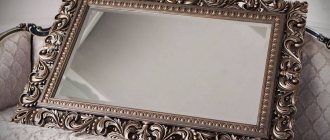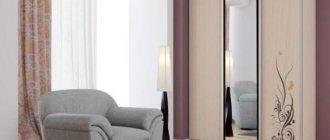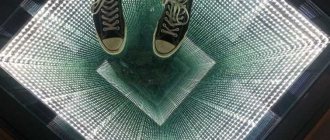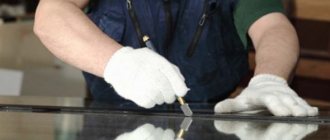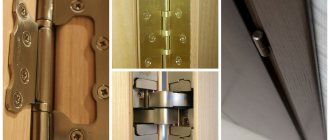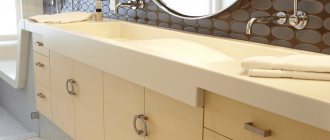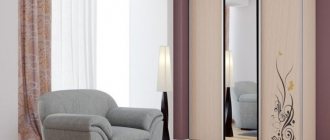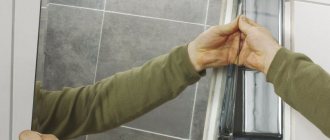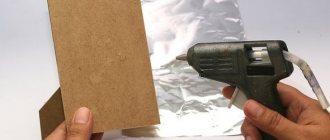Installing a mirror in the bathroom. Mounting methods and types of installation
Installing a mirror in the bathroom with your own hands is quite a complex and responsible process for those who have never encountered the installation of mirror surfaces. The fragility of the object requires careful handling and accuracy in work. A properly prepared and equipped workplace, as well as compliance with all installation conditions, guarantees the creation of a beautiful and sophisticated interior in the bathroom. There are many different ways to mount a mirror in the bathroom. The variety of options makes it possible to place a mirror according to any design decisions, decorating the space harmoniously and in combination with decorative elements, emphasizing the individuality and style of the room’s equipment.
- Hanging a mirror
- Types of fastenings
- Attach the mirror using adhesives
- Fastening the canvas using staples
- Conclusion
First way. Using an adhesive
The least labor-intensive method that allows you to securely attach the mirror to the tile surface. The main disadvantage is the inevitable difficulties if the mirror has to be dismantled for any reason. There is a large selection of different adhesives that allow you to securely glue the mirror directly to the tile. These are special tile adhesives, “liquid nails” and many other names. Before purchasing glue, you should carefully read the instructions for use: this will ensure that the selected glue is suitable for the job.
The adhesive composition must be used in strict accordance with the instructions for use: this guarantees a strong connection and durability of the adhesive seam. It is best to apply the adhesive to the mirror in parallel strips at equal intervals: this will evenly distribute the load on the adhesive seam.
Pre-degrease the tile surface. After applying the adhesive to the mirror, it must be pressed against the wall and fixed in this position for a while.
This method is only suitable for attaching small mirrors: the surface of the tile is smooth, so to attach large mirrors directly to the surface of the tile, it is better to use a combined method - a combination of adhesive and double-sided tape.
Gluing
This method is more gentle on the wall. Suitable for walls made of lightweight materials - plasterboard, foam concrete, etc., concrete and brick walls, when there is no drill, and for coatings that cannot be damaged - tiles, plastic boards, etc. It makes sense to glue small and light mirrors without a frame. Because the adhesive may not be able to cope with heavy weight.
Glue
The simplest and most obvious way to glue a mirror to a wall is construction glue. It can be used to attach the canvas to a cabinet or wall; waterproof compounds are suitable for the bathroom. Before use, you need to carefully read the composition and characteristics of the glue - if they are chosen incorrectly, then the effectiveness of the work will be zero.
The mirror can be glued to almost any surfaceSource allegroimg.com
Sequence of work:
- The wall must be smooth and clean - it is first wiped and allowed to dry;
- Make markings on the prepared wall;
- Glue is applied to the back of the mirror;
- If the mirror is too large, glue is applied to the wall;
- Using special suction cups, the mirror is placed on the wall exactly according to the markings;
- Leave it like this until the glue dries.
The drying time for all compositions is different, it is indicated on the packaging. Until the glue has completely set, the surface should be protected from water and mechanical influences. After this has happened, the fastening can be considered reliable.
Sealant
The method of fixing a mirror to the wall using sealant is no different from using glue. Most construction sealants are waterproof, but are not suitable for gluing large, heavy mirrors. Suitable for tiles and plastic panels, but does not adhere well to wallpaper. Ideal for the bath, good for the hallway and room, but most of them are not suitable for the kitchen.
Double sided tape
The main advantage of such fastening is cost-effectiveness. Disadvantage - suitable only for a limited number of surfaces and mirrors.
It’s easy to glue a mirror with double-sided tapeSource new.peredelka.tv
Works well for small, lightweight canvases that need to be mounted on plastic panels. Things are a little worse with tiles. An ideal solution for mirrors of complex shapes and assembling mirror panels from small fragments.
Features of working with double-sided tape:
- It should be glued in small fragments, and not as a whole canvas;
- Marking the wall is also required;
- The adhesive tape must not be abruptly removed from the surface - damage may occur.
The main advantage of this mounting method is the ability to rehang or adjust the mirror at any time.
For a visual demonstration of gluing a mirror, watch this video:
At what altitude
Before you hang the bathroom mirror on the tiles, you need to decide on the height for it. It should ensure convenient but safe use of the reflective element for all family members. The optimal installation height is determined as follows:
- If there are children in the family, the lower edge of the canvas should be at a height of 1.2 m from the already tiled floor. This will allow children over 5 years of age to use it, and younger family members will not be able to damage it. If there are no children in the house, the installation height is chosen based on the height of the shortest family member. In this case, the lower edge of the product is placed 2 cm below the solar plexus point or at least not higher than the chest of this person.
- To ensure that the canvas is less covered by splashes of water and soap, the mirror is installed at a height of 20-40 cm from the edge of the sink.
- The height size of the mirror plate is chosen based on the height of the tallest family member so that the upper edge of the accessory is located 2 cm above the person. Additionally, the height of the doorway is taken into account. It is believed that the product should not be higher than the top edge of the door jamb.
Fastening methods
Mounting a mirror on a wall is done using the following methods:
- using mounting tape;
- adhesive compositions;
- screws;
- liquid nails to tiles;
- suction cups;
- cord;
- hinges with several degrees of freedom.
These methods are suitable for working in standard bathrooms.
Between tiles
Walls are damaged during the process of drilling holes for fasteners. The tile has the ability to crack and burst during the procedure. It is advisable to drill in the seams between the panels, but it is possible to make a recess in the tile itself. It is better to take a special drill designed for tiled surfaces.
We use liquid nails
Fastening with a solution of liquid nails is durable and reliable. It can be used in rooms with a high percentage of humidity, following the following sequence:
- Using liquid nails, attach the profile to the selected location.
- We add a piece of waterproof drywall to it.
- When the two materials are well combined, glue the selected mirror coating onto the top of the drywall using the same liquid nails.
The disadvantage of this mount is the inability to subsequently remove and rehang the reflective glass to another location.
IMPORTANT! The mirror should be mounted on a plasterboard surface, and not on a tile.
Installing a mirror with hooks
You can secure the mirror in the bathroom with hooks. To do this, place the mirror on the installation site, and use a marker or pencil to mark the position of the upper edge.
Next, measure the length from the marked line, which is equal to the distance from the top edge to the fasteners. Carry out a similar operation with marking the distances from the sides of the mirror.
The result should be two main points for the hooks on which the canvas will be attached. If the manufacturer provides more fasteners, then you need to mark their positions on the wall.
Next, a diamond-coated drill with a diameter half the size of the required hole is installed in the drill.
Drill the tiles at right angles to the main wall material with minimal pressure on the tool and short stops for 2-3 minutes to prevent overheating.
After this, change the drill to a similar one, but with a diameter for a self-tapping screw or dowel, and drill a hole of sufficient depth in the tile. Carry out similar operations for the required number of fasteners, then drive dowels into them and screw the hooks onto the screws.
If minor distortions are allowed, then the canvas can be removed and the screws slightly unscrewed and the hooks moved.
How to hang a mirror in the bathroom?
If there is tile on the wall in the bathroom, and it’s brand new, you don’t really want to drill into it.
Doubts plague me: “What if it cracks or falls off along with the mirror?” What to do? It is best, of course, to prepare a place under the mirror in advance. That is, choose and buy plumbing fixtures, bathroom furniture and a mirror before the renovation begins. Having chosen the place where the mirror will be located, you can not cover it with tiles, but leave free space. If the wall in this place is concrete or brick, attaching a mirror will not be difficult. However, it will hang here until the next repair. Well, if the repairs have already been done, there are several options. The first is suitable for those cases when the mirror is really heavy, and hanging it with glue seems impractical. You will have to drill the tiles and the wall.
We hang a mirror in the bathroom. Drilling
There is no need to be afraid that the tile will crack - if the tile itself is of high quality and is glued well, nothing will happen to it. First you need to choose a place for the mirror, using a level to make a line where the mirror will be attached. Holes must be made in this place. Their number depends on the width of the mirror and the number of fasteners on it (if the mirror was already sold with holes for fasteners and with the fasteners themselves).
| To hang something relatively heavy on a concrete, brick or drywall wall in a conservative and therefore reliable manner, you will need a drill and a hammer. Of course, you also need to buy screws and dowels or purchase anchors. If you do not understand this variety of fasteners, explain to the consultant in the store for what purposes you need the fasteners. After clarifying the details (the quality of the wall, the weight of the suspended object, etc.), the seller will select the optimal fasteners for you and explain how to use them correctly. |
Even before the tiles
In fact, this is a separately presented option. But I still want to say a few words about him.
There is a great solution. This is relevant if the bathroom is being renovated and the tiling has not yet been completed. There are actually 2 options:
- First option
. The bathroom is completely tiled, but there is space left for a mirror sheet. A layer of tile adhesive is applied to the wall, and then the canvas is applied. This way the mirror is flush with the tile. You will need to cut the mirror exactly to fit the selected area so that everything looks beautiful; - Second option
. It's just the reverse sequence. First, the mirror is glued, and tiling is done around it.
Not exactly a life hack, but the option is quite convenient and interesting.
But practice shows that mirrors are often attached after finishing the tiles.
Therefore, let's see how you can glue or install mirrors on existing tiles. To do this, you need to look separately at light and heavy elements.
